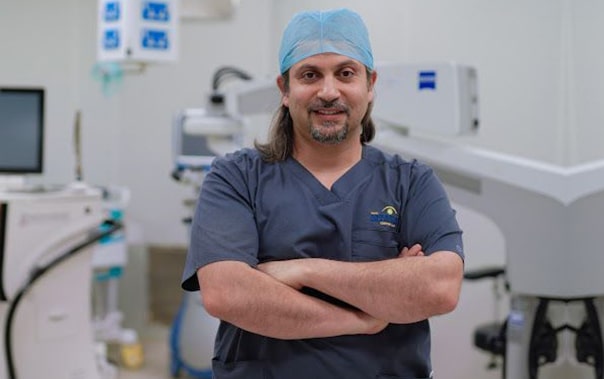Glaucoma Eye surgery aims to reduce the pressure within the eye, stabilize vision and prevent vision loss in the future.
Glaucoma Surgery Options
Excess fluid from the eye is removed by making a tiny cut on the white part of the eye to reduce the pressure.
Using a laser, the surgeon makes a small hole in the iris to relieve pressure and drain fluid.
Pressure is immediately reduced and controlled by a unique flow restrictor
A combination of glaucoma surgeries that uses stents and micro shunts to lower the pressure in the eye.
Glaucoma surgery aims to reduce the pressure within the eye, stabilize vision and prevent vision loss in the future. An opening is created to allow fluid to drain from the eye – or a shunt is implanted to assist with draining.
In addition to eye drops, laser treatments, and surgery, various treatments are available for glaucoma. Depending on your circumstances, you may need a different type of treatment.
Glaucoma Surgery & Treatment Options
There are several types of glaucoma, and the treatment you receive will largely depend on the type. The treatment used is often a primary open angle glaucoma, which is usually treated with eye drops. It may be necessary to undergo laser treatment or surgery if drops do not provide relief.
Treatments for other types of glaucoma include:
● Glaucoma with primary angle closure – immediate treatment in hospital with medicine to relieve eye pressure followed by laser surgery.
● Treatment for secondary glaucoma may include eyedrops, laser treatment, or surgery, depending on the underlying cause.
A trabeculectomy involves removing the excess fluid from the eye by making a tiny cut on the white part of the eye. The trabeculectomy is a type of glaucoma surgery that drains fluid from the eye by creating a new pathway. As an outpatient procedure, the procedure is performed in the operating room.
The surgery reduces eye pressure to prevent the worsening of glaucoma-related vision loss.
It is impossible to restore vision after a trabeculectomy if it has already been lost. However, this procedure prevents further loss of sight caused by glaucoma.
Ahmed glaucoma valves are an effective surgical technique for reducing intraocular pressure in patients with glaucoma. Pressure is immediately reduced and controlled by a unique flow restrictor on the Ahmed Glaucoma Valve. There is no better glaucoma drainage device in the world.
By improving fluid flow inside the eye, micro-invasive glaucoma surgery (MIGS) reduces intraocular pressure. The MIGS procedure reduces infection risks and speeds up recovery time
It is possible to treat or prevent closed-angle glaucoma with LPI, a laser procedure performed in an office setting.
To facilitate fluid drainage from the eye, a small opening is created in the iris (coloured part of the eye). It prevents rapidly increasing eye pressures, irreversible optic nerve damage, and permanent vision loss by reducing the chances of the drainage pathway closing.

Are you ready to join the 300 happy patients who have taken control of their glaucoma and are now seeing better? Schedule a free consultation to learn the next steps for glaucoma treatment.
At the North American LASIK and Eye Surgery Centre, we perform weekly eye surgeries and we have done over 16,000 surgeries since we first opened our clinic in 2013.
Our founder, Dr. Abdulla Naqi, and the team of surgeons have over 30 years’ experience and have done over 16,000 eye surgeries.
Our commitment to all our patients is that they receive treatment in terms of quality and care. The North American Lasik and Eye Surgery Centre are accredited by the Emirates International Accreditation Centre (EIAC).

Frequently Asked Questions
Glaucoma is like Diabetes, once you have it, it stays with you. In addition to irreversible damage to the optic nerve, retinal nerve fibers are also permanently damaged. By treating the condition, you can prevent the condition from worsening, and you can save your vision. This is why early diagnosis and treatment are crucial.
Scientists still do not know what causes Glaucoma. An important factor contributing to the damage is a blockage of the passages that drain the fluid within your eye. A buildup of fluid in your eye puts pressure on the optic nerve. This pressure damages the optic nerve’s delicate nerve fibers and blood vessels, resulting in vision loss.
Most people with glaucoma do not notice any symptoms until their vision has silently and gradually worsened to a severe stage. Most people with glaucoma are not aware they have it. It is why glaucoma is often referred to as “the thief of sight” and is still one of the leading causes of blindness.
When glaucoma is in its early stages, peripheral (or side) vision is usually affected. It is a common misconception that people affected by glaucoma develop tunnel vision. Patients with glaucoma rarely experience tunnel vision. A subtle blurring near the nose is the first sign of vision changes.
In the case of vision loss in one eye, the other eye often covers it up and conceals it. In the absence of treatment, areas of vision loss will slowly spread and may go undetected until they reach the central vision.
Secondary angle-closure glaucoma can develop as a result of a swollen cataract. Phacolytic glaucoma is a type of secondary open-angle glaucoma caused by hyper mature cataracts with liquefied cortex. There is a significant increase in intraocular pressure in both conditions, causing redness and pain in the eyes.
Glaucoma is a progressive disease but can be halted when the correct treatment is started early on.
Glaucoma may be treatable with non-surgical methods if you catch it early enough. Oral medication and medicated eye drops are some non-surgical treatments. If you’re considering non-surgical procedures, speak to your eye doctor first.
It is important to note that there are different types of glaucoma and, as a result, different types of glaucoma eye surgeries. To treat your specific type and stage of glaucoma, your eye surgeon will recommend the appropriate type of surgery.
One of the most common glaucoma eye surgeries involves opening the eye’s drainage angle using a laser to allow fluid to drain correctly. The laser peripheral iridotomy procedure promotes eye drainage by creating a small hole within the iris.
An ophthalmologist can evaluate your angle (gonioscopy) and optic nerve with dilation if necessary to diagnose glaucoma. Further tests may include an optic nerve photograph or analysis and a visual field test.
You may experience blurry vision after glaucoma surgery. In some cases, this can last as long as six weeks. The first few days following surgery are often marked by inflammation, swelling, redness, or irritation in the eye.
While the procedure itself is not painful, you may experience some discomfort due to the brightness of the operating light, and you may experience fluid washing over your eye and spilling down your cheek. It is possible to experience small tugging sensations while removing the sutures.
The first few days your eye may feel inflamed and itchy. Wearing your eye shield at night for at least two weeks, or as long as your surgeon recommends, is essential after glaucoma surgery.
